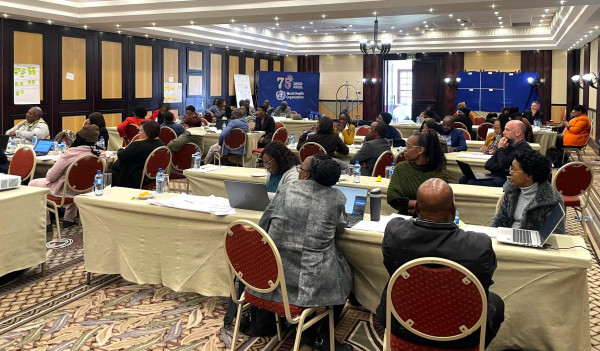

The Ministry of Health and Social Services in collaboration with the World Health Organization (WHO) recently gathered for an After-Action Review (AAR) meeting in response to the recently ended Crimean Congo Haemorrhagic (CCHF) outbreak. Various stakeholders gathered in Windhoek for a three-day meeting from 1-3 August 2023, to document activities that were carried out during the recently ended CCHF outbreak.
The meeting also served as an opportunity to evaluate Namibia’s preparedness and response capacity to the CCHF outbreak. The outbreak was confirmed in the Gobabis District of the Omaheke Region on 21 May 2023. This is after one person, who was confirmed to have had CCHF died three days prior.
The Minister of Health and Social Services, Dr Kalumbi Shangula declared the CCHF outbreak on 22 May 2023. Only one confirmed case was reported during the outbreak. According to the National Integrated Disease Surveillance and Response (IDSR) 3rd Edition Technical Guidelines, a single confirmed case of CCHF constitutes an outbreak. Fifty-six contacts were identified and monitored during this outbreak and no infection was recorded among the contacts, prompting Dr Shangula to declare an end to the CCHF outbreak on 19 June 2023. Subsequently, an AAR needed to be conducted as it is one of four International Health Regulations (IHR 2005) Monitoring and Evaluation framework components which is recommended within three months after the end of a public health response.
Through the AAR methodology, fifty-eight multi-sectoral participants were able to conduct a qualitative review of actions taken to respond to the CCHF outbreak as a means of identifying gaps, lessons learnt and best practices. The AAR was a necessary step to bring together all partners who contributed to the success of the government response to end the CCHF outbreak.
The AAR participants were from the Ministry of Health and Social Services national level directorates, regional health directorates, health districts, public health facilities and private facilities. The other participants were health partners from organizations including the WHO country office, Namibia Red Cross Society, Namibia Institute of Pathology, City of Windhoek, Namibia Field Epidemiology and Laboratory Programme, Robert Koch Institute, Farmers Union and Ministry of Agriculture, Water and Land Reform.
During the AAR workshop, participants were divided into seven groups representing the response areas of the CCHF outbreak, namely; Coordination, Surveillance, Case management, Infection and Prevention Control (IPC), Risk Communication and Community Engagement (RCCE), Laboratory, Psychosocial support and Safe dignified burial.
The workshop involved the participants recalling and documenting the preparedness and response activities that were in place before and during the outbreak in five steps by asking critical questions. The questions were: ‘What was in place before the response?’, ‘What happened during the response?’, ‘What went well?’ What did not go well?, ‘What can we do to improve for next time?; What is the Way Forward?’
Some of the best practices that were identified during the response are;
• timely activation of the management committees at all levels to ensure a well-coordinated response of activities.
• outbreak response interventions through one health approach of Human and animal to limit further spread of the outbreak.
• utilization of real-time communication platforms to ensure the implementation of resolutions and action plans of the response.
• strong collaboration with partners and stakeholders in mobilizing of resources for the response.
The review ended with participants developing a comprehensive action plan for the implementation of corrective actions to enhance preparedness and improve future responses to CCHF and other emergencies.
The action plan highlighted the prioritized activities to institutionalize the best practices and address the challenges, a timeline for implementation of actions and a follow-up mechanism.
During the AAR, participants from the Ministry of Health and Social Services emphasized the importance of ensuring that the AAR participants take this as another learning opportunity and capacity building, and make sure that corrective actions developed are implemented for any other future possible public health event.
Emphasis was made on the need for the government, partners and stakeholders to always engage and work together with the communities during outbreak response. WHO will support the Ministry of Health and Social Services in developing the corrective action plan according to the gaps identified during the AAR and to finalize the AAR report.
Namibia previously conducted after-action reviews for CCHF and Hepatitis E Virus outbreaks in 2017 and 2022. This is the first time the country has conducted an AAR with minimal support from the World Health Organization Regional Office for Africa (WHO AFRO).
This highlights the capacity built in the country at both the WHO country office in Namibia and the health ministry’s ability to conduct AARs. WHO Namibia appreciates the continuous support received from WHO AFRO in building the country’s capacity to conduct AARs with minimal external country support.
Distributed by APO Group on behalf of World Health Organization (WHO) – Namibia.






